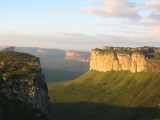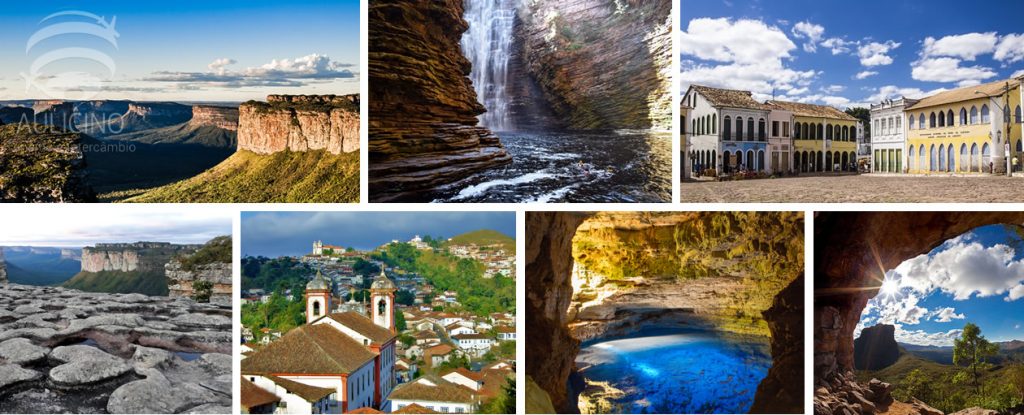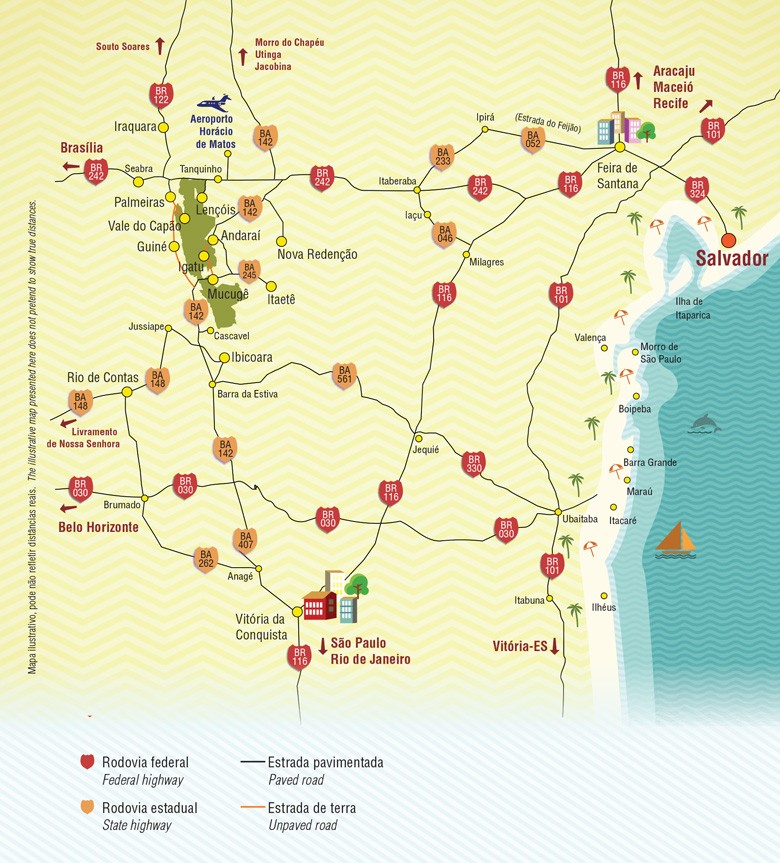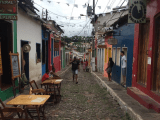Este post também está disponível em:
Português
English

The scenery of Chapada Diamantina, world famous for its rich biodiversity, is formed by landscapes of mountainous relief, free falls, underground lakes, as well as a large number of springs, waterfalls, rapids, canyons and caves that make it an excellent place for the practice of adventure tourism and ecological tourism.
The Chapada Diamantina is one of the 5 main chapadas in Brazil.
Its main attraction is the Chapada Diamantina National Park.
Located in the central region of Bahia, the municipalities of Lençóis, Palmeiras, Iraquara, Andaraí, Mucugê, Rio de Contas and Morro do Chapéus are included in these circuits have their history related to important moments of national life, such as the exploration of mining in the seventeenth, eighteenth and nineteenth centuries.
The region of the Chapada Diamantina National Park, in the heart of Bahia, developed with the mining of gold and diamond mining in the 18th and 19th centuries.
View the map Chapada Diamantina
Once the deposits were exhausted, the main means of survival for the population became farming.
Numerous stories are told about the time when powerful colonels who owned a lot of land and commanded “armies” of jagunços, made their own laws and had the power of life and death over people.
The 152,000-hectare park, an environmental preservation area administered by IBAMA, covers Lençóis, Palmeiras, Andaraí, Mucugê, Itaeté. Iraquara, Seabra and Ibicoara, towns that retain their old mansions and churches from the mining days.

The listing in 1973 and the creation of the park in 1985, in addition to protecting the ecosystems of the Serra do Sincorá and preventing the deterioration of sites of historical and cultural interest, encouraged tourism in the region.
Until two decades ago, only backpackers went to the Chapada. The recent improvement of the tourist infrastructure, the opening of good standard hotels and the construction of an airport have facilitated the operation of receptive tourism companies. Today, Brazilians and foreigners visit the caves, waterfalls, rivers, valleys and mountains.
Many come to the region to practice sports such as trekking, mountain biking, canoeing and rappelling. The sites that were quilombos attract tourists interested in knowing typical dishes and popular festivals.
Visual artists, esotericists and people seeking “immediate contacts” with extraterrestrials also visit the site.
As the deposits were exhausted long ago, you won’t find gold nuggets or diamonds. The treasure waiting for you is the Chapada itself.
View the map Chapada Diamantina
Map of the Trails and Tourist Spots of Chapada Diamantina

Video about Chapada Diamantina – Travel and Tourism Tips

Pontos Turísticos da Chapada Diamantina
Tourist information about Chapada Diamantina
- Overview
- Where to stay
- How to get there
- When to go
- Main tourist attractions
1. Overview
The numbers in Chapada Diamantina are grandiose: more than 200 waterfalls, 200 caves, 1,500 kilometers of trails and a national park of 152 thousand hectares.
The destination is in the heart of Bahia, 420 km from Salvador and far from the beaches that have made the most seductive of Brazilian states famous. But it displays a tangle of unprecedented beauty.
You can explore it all in different ways: by car, by bike, or on foot, setting up base in one of its 24 small towns or sleeping each night in a different place, camping or staying in comfortable hotels with a good king size bed.
It all depends on what kind of tourist you are – or are willing to be.
For first-timers, it’s best to book at least a week – with less time, you risk returning home frustrated with the number of attractions that have been left out.
The truth is that there are enough activities and natural beauty for much longer stays. Once there, it is best to rent a car to drive around and get to know the main tourist attractions in the region. Another option is to hire a Back to the Park package, which includes transportation and the most popular attractions in Chapada.
2. Where to stay
1. Lençóis
The most obvious base is Lençóis, which has a good range of hotels and restaurants and an airport with flights to and from Salvador.

With colonial airs, the city is charming and lively at night, especially in the vacation months. But there are other interesting options.
2. Vale do Capão
Vale do Capão concentrates the hippie class.
3. Mucugê
Mucugê is quiet and has beautiful houses, as well as an unusual Byzantine cemetery. Guiné is ideal for those who intend to face the arduous trekking in the Pati Valley.
4. Igatu
And Igatu is an attraction in itself. The most picturesque of the Chapada villages is a legacy of the golden age of diamond mining in the region, which peaked between 1844 and 1871.
The village once had 9,000 inhabitants, a movie theater and an imported goods store. Today it has 500 residents and a bucolic atmosphere, but the history is still present in the architecture and lifestyle of its residents.
Listed by Iphan, the ruins of the stone houses that belonged to the miners are located at one end of the district and, mixed with the vegetation, make up a scenario reminiscent of European stone towns.
The various trails and natural attractions of Chapada Diamantina guarantee the presence of ecotourists, hippies and even residents of large cities in search of reconnection with nature. Terms such as trekking, trails and adventure, however, can alienate those who like comfort, do not enjoy long walks and avoid at all costs any kind of hardship on vacation.
The good news is that some of the best attractions in the region require little or no physical effort – and are accessible even to the most sedentary. We have divided the main attractions of the destination by level of physical effort.
Choose yours and go prepared to come back different.
3. How to get there
- Air
Azul flies to Lençóis on Thursdays and Sundays from Salvador.
- Bus
By bus, from the capital of Bahia, it takes about 7h with Rápido Federal (R$ 88,16 the stretch). Consider renting a car to have more mobility between attractions.
4. When to go
You can go to Chapada all year round.
In the summer, it rains more and the waterfalls are full.
Winter has very cold nights – think well about packing, especially if you’re going camping on a trail. From February to October, there is light at Poço Azul.
Main tourist attractions
- Map of the Chapada Diamantina National Park
- Map Chapada Diamantina
- Map of Trails and Tourist Spots
- The Highest and Most Beautiful Waterfalls
- History of Garimpo
- Vila do Ventura and Rupestrian Trail in Morro do Chapéu
- Igatu, Poço Azul and Poço Encantado
- Marimbus is the mini pantanal
- Trekking to the Pico das Almas, Barbado and Itobira
- Everlasting Flower is typical of Chapada Diamantina becomes a symbol of preservation
- Emerald hunters
- Get to know the diving spots
- Fruits of the Municipality of Campo Formoso in Bahia
- Rio de Contas is considered the first planned city in Brazil
- Curiosities of Rio de Contas
- Tourist Guide of Rio de Contas in Bahia
- Rio de Contas one of the oldest of the region
- Piatã is the highest mountain town in the entire Northeast with an altitude of 1180 m
- Palmeiras lived its glory days with diamond extraction
- Mucugê is at 900m altitude amidst a privileged landscape
- Morro do Chapéu is at 1012 m altitude and offers a pleasant climate
- Lençóis is the gateway
- Iraquara is also known as the “City of Caves”
- History and Tourism Guide of Ibicoara in Bahia
- Andaraí which is the second main city
- Chapada Diamantina is world famous
- Vale do Pati – Trekking in the heart of Chapada Diamantina
- Trekking – Route through Chapada Diamantina
- Poço Azul
- Enchanted Well
- Torrinha Cave in Iraquara
- Gruta do Lapão
- Lapa Doce Cave and Pratinha Cave
- Trekking in the Pati Valley
- Fumaça Waterfall in Vale do Capão
- Trekking – Most Popular Trails
- Orchids of Chapada Diamantina
- The charm of Cachoeira da Fumaça
- Cachoeira do Buracão
- Chapada Diamantina Relief, Fauna and Flora
- Documentaries
- Tourist Guide of Chapada Diamantina
- History of the settlement of Chapada Diamantina BA
Bahia.ws is the largest tourism and travel guide for Bahia, Salvador and Northeast Brazil
Chapada Diamantina Tourism and Travel Guide in Bahia



















